Hip Valencia, Spain! Santiago Calatrava City of Arts & Sciences, Michelin restaurants, futuristic architecture.
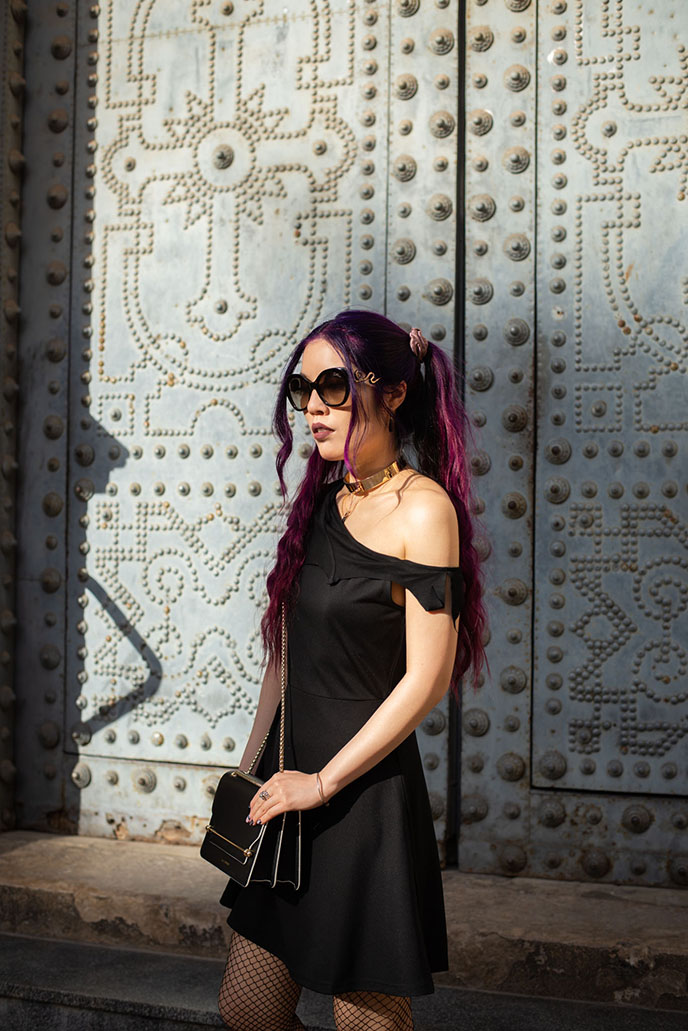
Valencia tends to be overlooked by travelers to Spain, who tend to visit well-known spots like Barcelona. But as you’ll see in this photo diary, Valencia is a gem of a destination with space-age architecture, Baroque carvings, Michelin-starred restaurants… and for you Goths out there, the city even has a bat as its mascot.
This mega-post will cover it all, along with outfit photos taken in the most Instagrammable locations in the city. (I was delighted to be invited to Valencia by the tourism board last November.)
Outfit details: Robert Cavalli snake sunglasses, Strathberry East / West purse, Fantasmagoria dress with batwing collar. See more with a click below:

Let’s start by visiting the City of Arts and Sciences, which looks like a scene from The Jetsons. Designed by Spanish architects Santiago Calatrava and Félix Candela, Ciutat de les Arts i les Ciències was inaugurated in 1998, with additional buildings added to the complex up to 2009.

My devilish look for the day included a Strathberry crossbody purse, and Satanic dress with a pentagram straps / harness detail.

You can easily spend hours exploring the enormous Valencian cultural / architectural complex. The many curving, white modern structures include L’Umbracle — a landscaped garden dome that includes a Walk of the Sculptures.

Here is Museu de les Ciències Príncipe Felipe — an interactive science museum of science with a roof designed to resemble the skeleton of a whale.
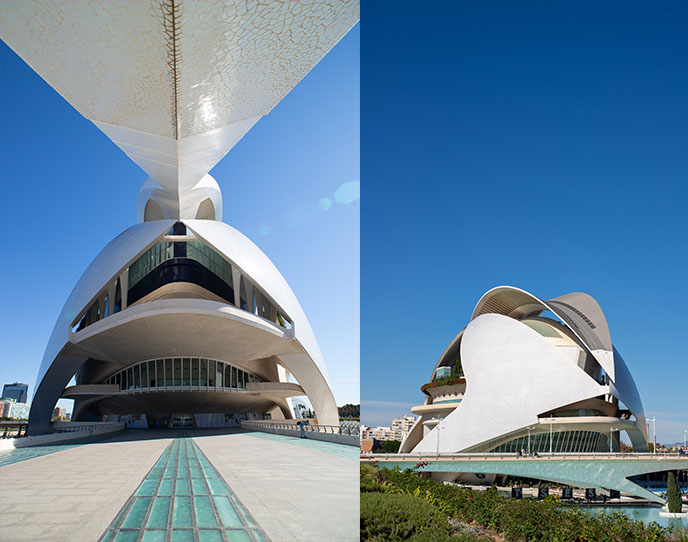
Behold, the Palua de les Arts Reina Sofía — an opera house and performing arts center surrounded by water. Many leading musicians have performed within these eaves.
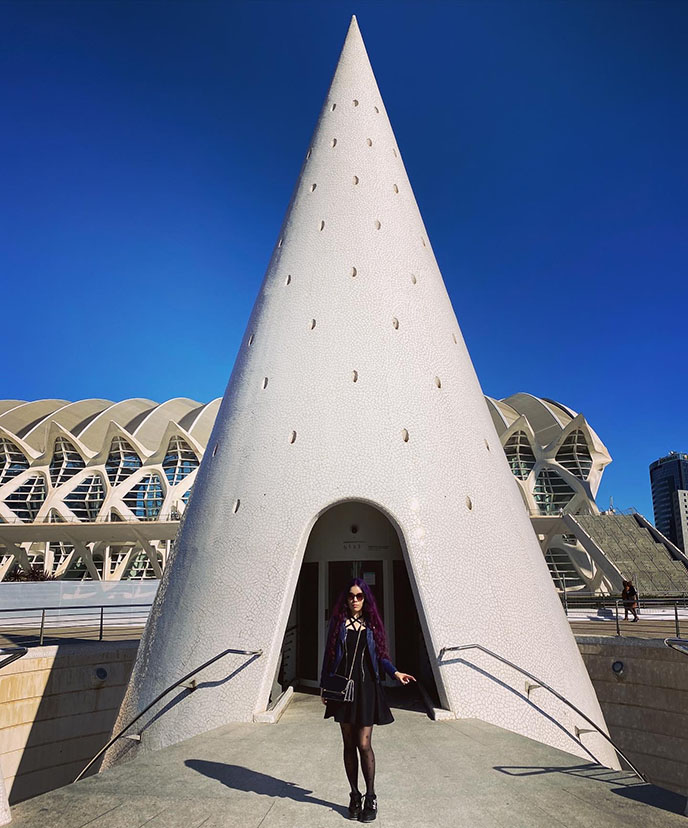
I let my imagination run wild, as I walked around the City of Arts and Sciences. The geometric, bone-white designs made me feel like I was in a sci-fi movie. These cone simply holds an elevator that leads to the garage!

The Ciutat de les Arts i les Ciències includes L’Hemisfèric, which contains an IMAX Cinema, planetarium and laserium. The building is meant to resemble a giant eye of knowledge.

I enjoyed walking around Calatrava and Candela’s buildings, and noting how the shapes changed when viewed from different angles.

There were so many fascinating elements that I couldn’t photograph them all. The City also includes L’Oceanogràfic, an open-air oceanographic park, and a curving white cabled bridge called Assut de l’Or.

You’ll be hard-pressed to find a better spot for Instagram and fashion photography. (Strathberry purse, and see more items below):

I’ve long been a fan of architect Santiago Calatrava, known for his white spaceship-like designs inspired by organic forms. You may recall I saw his Brazil Museum of Tomorrow and World Trade Center subway station in NYC.

Duck under Montolivet Bridge, and see the glimmering reflections of the water on the concrete curves.

Look for the light in unexpected places… This is a transportation area that turned out to be a great shooting spot.

There are rotating public art exhibitions throughout the City. This rather emo bunny rabbit sculpture is “Aqui Estamos” (Here We Are) by Leiko Ikemura.

Details, details. Can’t get enough of the architectural creativity, such as the zig-zag stair railing that mirrors the peaks of the roof and windows.

All photos by Joey Wong — love how he always finds that sliver of light.

Isn’t the City of Arts and Sciences dazzling? I half-expected a UFO to land here.
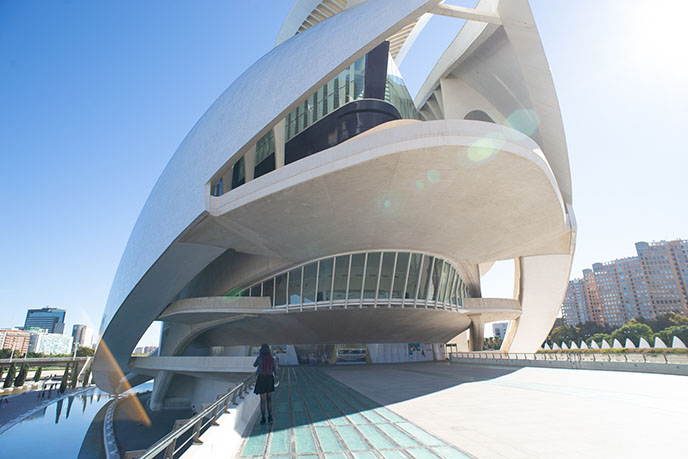
Don’t miss this eyepopping site if you’re in Valencia. Bring a camera, and enjoy the various events, performances, and museums within it.

Valencia Tourism also took me on a city tour to see the historic side of the city — which is just as fabulous. The main district is filled with churches, buildings, sculptures, fountains and pavilions that date back centuries.

The star of the show is Valencia Cathedral, also know as Saint Mary’s. Consecrated in 1238, the church is a fine example of Valencian Gothic architecture.

The ornate chancel of Valencia Cathedral is decorated with colorful 15th-century paintings.

Outside, be sure to snap a photo with the oldest door in the city, which is framed by multiple arches.

I learned that Valencia’s symbol is the bat — how vampiric! The nocturnal winged creature has perched atop Valencia’s coat of arms since around 1238, when King James of Aragon was fighting the Moors. Legend has it a bat landed on his flag and brought him good fortune, as he won the battle.

Look up as you walk around Valencia, and you’ll find the bat mascot everywhere — much like Batman’s beacon in Gotham City.
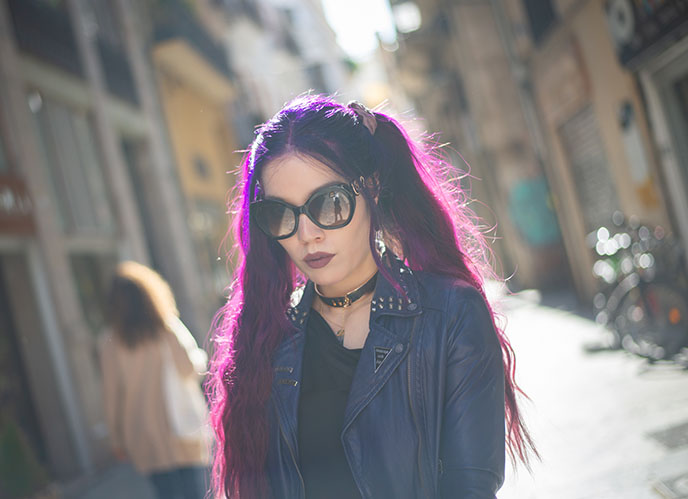
The bat element makes Valencia a fitting city for Goths! (Wearing Robert Cavalli oversize designer sunglasses.)

The walking tour continued on to Mercado Central, the major food market of Valencia. Completed in 1928 by Valencian architect Enrique Viedma Vidal, it is a stunning example of Spanish Art Nouveau.

The interior is a feast for the senses. You’ll find every type of vendor along with Iberian hams hanging from posts, and stacks of bright Valencian oranges (which are delicious).
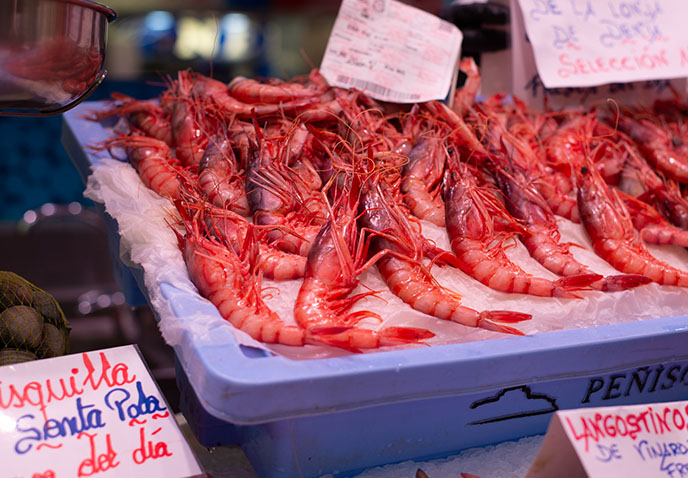
The seafood section is particularly tantalizing. Above are the famous Denia prawns found only in the waters near Valencia, and known as the tastiest and most expensive in the world.

On this trip, I met Valencian chef Danny Lledo and interviewed him about his quest to serve Denia prawns (gambas rojas de Denia) for the first time in America, at his DC restaurant Xiquet. Read my article about his journey here, in my debut for AFAR Magazine!
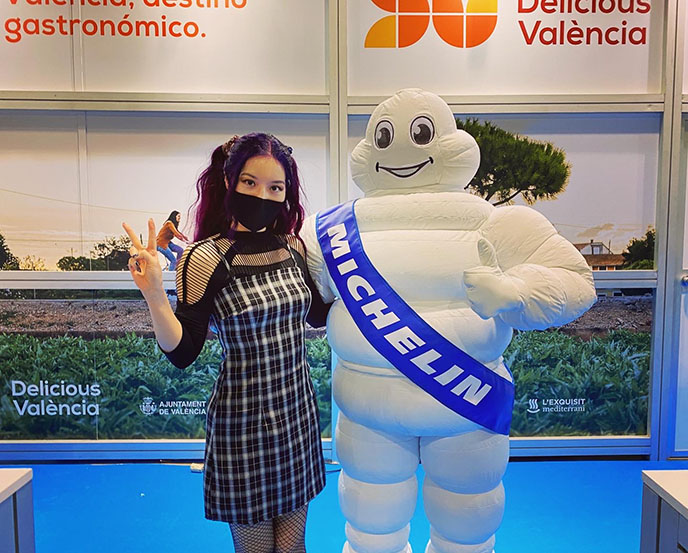
I also wrote an article for Fodor’s Travel about how Chef Danny Lledó turned his hometown cuisine into a Michelin star. Read how the chef’s childhood in a fishing town paved his path to winning paella championships and opening Michelin-starred D.C. restaurant, Xiquet.
I was a guest of Valencia’s Mediterranea Gastronoma food festival… and met the Michelin man himself!

Spain is known for its boundary-pushing culinary scene, and Valencia is home to a number of restaurants starred by the Michelin Guide.
I adored the industrial-style open kitchen and Argentinian-influenced tasting menu at Fierro. At the top: hake fish with seaweed, citrus, and pil pil (a collagen-rich sauce). Below: a creative dish entirely made from parsnips, including picked parsnips that have a spicy touch much like wasabi. The wine pairings were excellent such as Galician-grown whites), and Gran Fondillon dessert wine made from Monastrell.

I also ate at Michelin-starred La Salita, which had a whopping 16 courses prepared in innovative ways. The amuse bouche plate was beautifully presented: it includes corn tostada, colorless gazpacho, and a chilled caprese bite, decorated to look like flowers and a butterfly.
Each dish came with a story: the focaccia on the right was inspired by the bread brought by soldiers to war, which they softened with olive oil (La Salita uses Lagrima, the finest one). It was served with an eel soup with ikura (salmon roe), green apple, and cilantro — and paired with wines from the Valencian mountain region.

At a time when travel experiences are few and far in between, I feel unbelievably lucky to have done a food and culture journalism trip like this in Valencia.

After being in North America for two years, it felt like a palate-cleanser to be in a very different country / culture, and see buildings that dated as far back as the Middle Ages.

Artistic details like these make me happy. Would you dare to put your hand in the lion’s mouth?

Leave it to me to find bats throughout Valencia.

And I think this takes the cake for “most epic door.” This is the Palacio del Marques de Dos Aguas, which has now become the González Martí National Museum of Ceramics and Decorative arts.

The Valencian palace / museum’s main entrance is surrounded by Baroque alabaster sculptures.
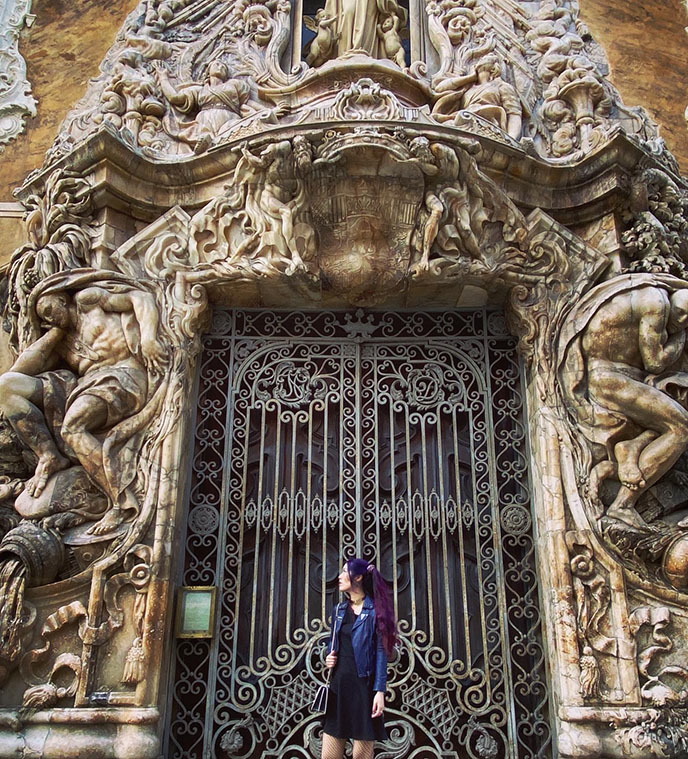
The amount of details in this doorway… phenomenal.

Museo Nacional de Cerámica y Artes Suntuarias González Martí is dedicated to ceramics (with a focus on Valencian ones), porcelains and other decorative arts such as textiles, costumes, and furniture.

I happened to wear a one-shoulder dress from Fantasmagoria with a batwing design at the collar… how fitting for a day exploring Valencia!

Details, details. My large gold choker necklace is the Safety Chain by Eddie Borgo. Sunglasses are Robert Cavalli.

Look up to see stately stained glass rotundas… and a gargoyle pleasuring itself!

Some travel outfit inspiration for you. I wore these Anthony Wang platform sneakers and a loose dress so that I could walk around comfortably all day. I dressed it up with fishnets and a leather jacket, and tied my hair with silk scrunchies.

A final Baroque facade: this is Church of the Santos Juanes (Església de Sant Joan del Mercat).

I hope this story convinces you to add Valencia to your itinerary, if you’re traveling in Spain!
If you liked my outfit of the day, you can find these designs below:

And cheers to all for reading and featuring The Little Book of Satanism! My latest book is featured in Auxiliary Magazine, as well as publications like Forbes and CBC.
You can get a copy of my “The Little Book of Satanism” from Amazon ♡ Kindle (digital) ♡ Barnes and Noble ♡ Bookshop and other retailers worldwide. Thank you for your kind support!
SHARE & COMMENT


 LA CARMINA
LA CARMINA







2 Comments
Love that dress with polyester fabric, the pentagram penticale wicca star lace really complements your purple’ish lavender hair nicely it’s very flattering and fashionable. The necklace adds that innocent yet playful touch.
Nice and lovely black outfits i seen ever. I really love it. It is also an informational blog from my side. Thanks for giving us that blog.